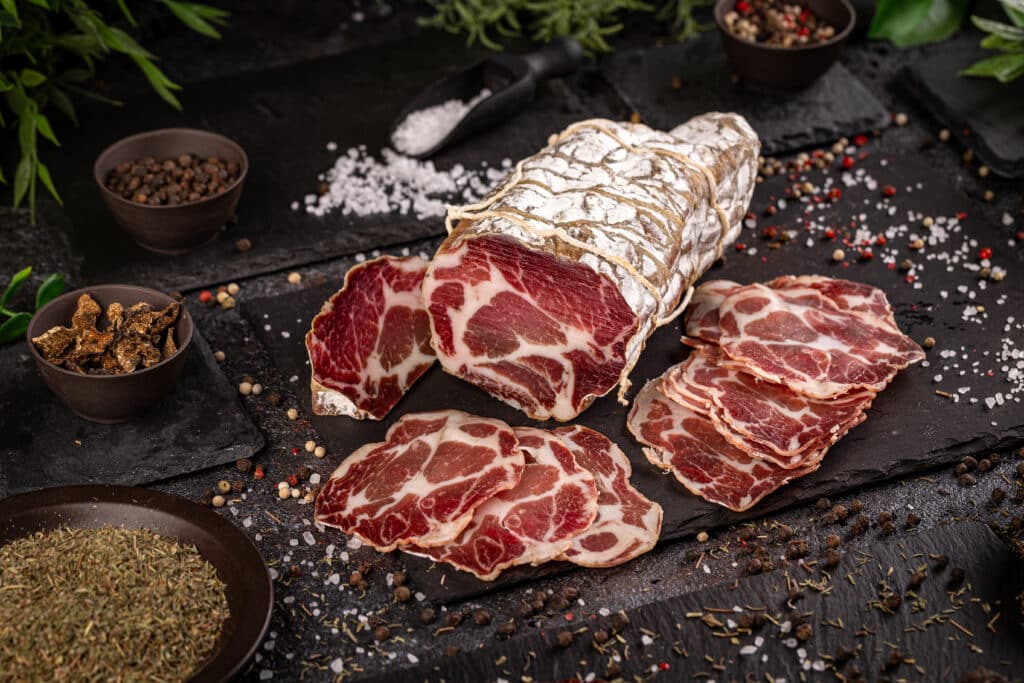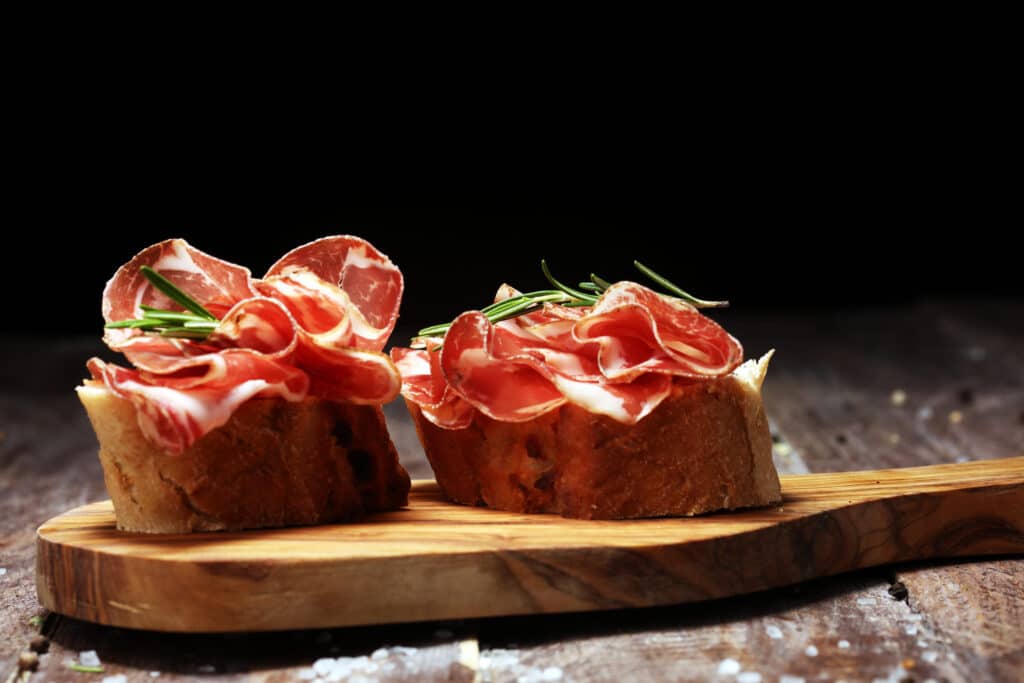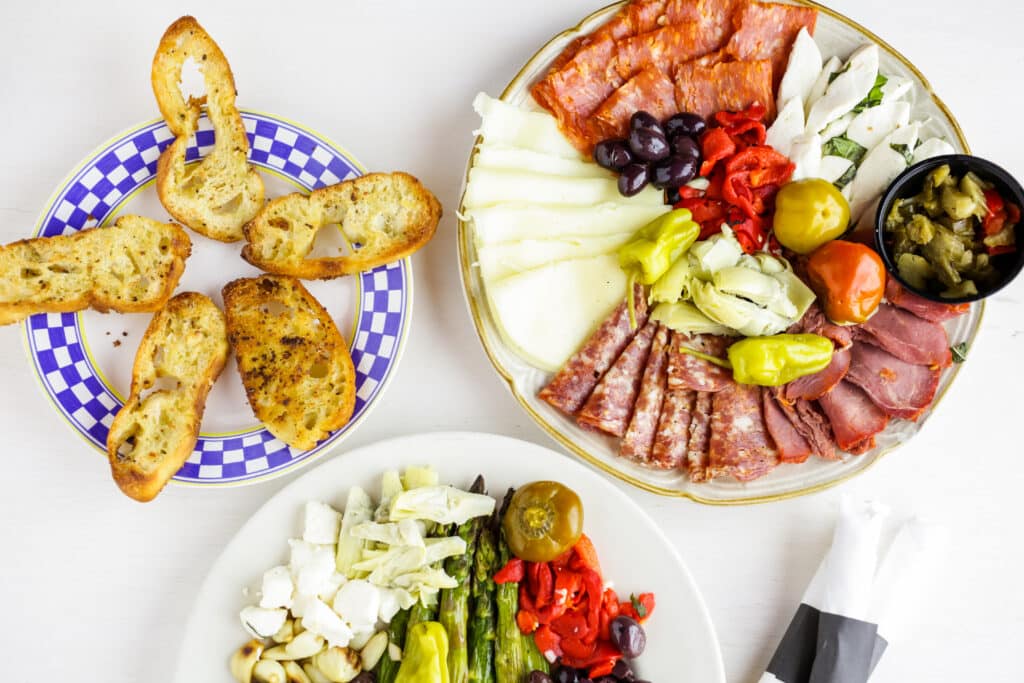Cappacuolo or Capocollo (Capicola/Coppa): What Is it and What Does it Taste Like?
Cappacuolo or Capocollo (Capicola/Coppa): What Is it and What Does it Taste Like?
Cappacuolo or Capocollo, sometimes called Capicola or Coppa, is a dry-cured Italian salami typically enjoyed thinly sliced as part of charcuterie boards or antipasto platters. Cappacuolo is a regional Italian dialect version of Capocollo, traditionally made in southern Italy.
Gabagool is an Americanized pronunciation or Slang of the word capicola! People say Gabagool in places like New York or New Jersey! You can even find it in the Sopranos TV show:
What Is Cappacuolo Made of?
Cappacuolo is a tender meat from pork shoulder. This type of Italian pork comes from a whole muscle taken from the neck and shoulder region of the hog’s body. The muscle, known as the ‘Coppa,’ weighs around 2.5-3 kilograms. Capicola contains an ideal combination of meat and fat.
How Is Cappacuolo Made?

Cappacuolo is dry-cured in a dedicated curing chamber using a complex process to make the meat safe to eat. Home Charcutier can substitute the chamber with a plastic bag to make Cappacuolo at home.
The dry cure meats use a mixture of salt, nitrate, and nitrite to remove harmful bacteria. The raw meat rests in the curing mixture for at least one week, during which nitrites kill harmful bacteria, such as Clostridium botulinum. Nitrates slowly decompose and release more nitrite to preserve the curing mixture’s overall antibacterial effect. Nitrites also give Cappacuolo its signature dark pink color. Nitrate and nitrites are used in very controlled amounts, as overuse can be harmful.
Another supportive measure to the dry curing process is to spray the meat with an edible, white bacteria starter culture that prevents harmful bacteria from penetrating the pork.
Cappacuolo can also be covered in herbs and spices of the curer’s choice during curing. Popular seasoning options include fennel seed, black pepper, cayenne pepper, smoked paprika, red pepper flakes, and garlic powder.
Once the pork meat has cured, the mixture must be rinsed off, and the meat air-dried under controlled humidity and temperature for about six months. Once the meat has lost around 35% of its weight through dehydration, there is no longer enough water for new bacteria to grow.
Is There a Difference Between Capicola and Coppa?
Coppa is traditionally made in the regions of Emilia-Romagna and Lombardy in Northern Italy. The cured meat has an exquisite flavor and soft textures, and marbling adds to its tenderness. Piacenza, a city located in Emilia-Romangna, also is famous for their coppa piacentina.
Capicola is produced in various regions in Italy – including Calabria, Campania, and Sicily and every region has its unique take and seasoning on this meat.
What Does Cappacuolo or Capicola Taste Like?
Cappacuolo tastes like salty pork with a hint of spice and smoke. The meat’s spiciness depends on the types of herbs used during the curing process. Whichever spice blend is used, the overall heat level remains low because the spices are only on the meat’s edge.

What Is the Difference Between Capicola and Prosciutto?
The difference between Capicola and Prosciutto is the portion of the pig that the cuts are taken from. Capicola is taken from the neck and shoulder region, whereas Prosciutto is taken from the pig’s hind leg (similar to ham).
Capicola and Prosciutto taste slightly different. Capicola has a marbling of fat throughout the entire cut, whereas Prosciutto contains a band of fat running along the outer edge of the cut. Prosciutto is usually more expensive than Capicola because Prosciutto takes longer to cure — sometimes over a year.
Despite the differences between these two cured types of meat, they’re both commonly found in charcuterie boards and antipasto platters and can substitute one another in recipes.
What Is the Best Way to Serve Capicola?

The best way to serve Capicola is as part of a charcuterie board or antipasto platter alongside other food. These platters typically contain cured meats, hard cheeses, red peppers, pickles, sliced apples, and chutneys.
Capicola can also be served as part of a salad, in a sandwich with vegetables, or alongside other cured meats.






